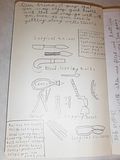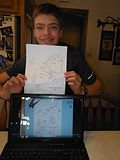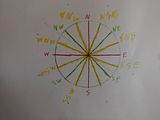Creation to Christ:
Singapore Math teaches place value in such a way that dc really do understand each place's value. I was not taught math this way back in ps. I was taught to just 'add this, carry that, why?, don't ask, just do it because you get the right answer.' I wish I'd been taught Singapore's way years ago - it sure would have saved a lot of time and pencil/paper work, and I sure would have been able to apply more what I'd learned to math needed in my life or my job!!

Singapore Math taught a great method to mentally add tenths and hundredths this week. I'll see if I can explain it, though Singapore Math really explains it best.

For 2.53 + 0.02, they had Riley combine the 2 hundredths with the 3 hundredths to get 5 hundredths, and then add 2.5 to get 2.55 mentally. The word bubbles on the side of the textbook page are super important to do. They had him saying the problem out loud like 'add 2 hundredths and 3 hundredths to get 5 hundredths'. These are the subtle differences in Singapore Math that mean all the difference because they have the dc making mental connections about the worth or value of each place a number may be (as opposed to saying 'point zero 2 + point zero 3', or as opposed to starting with the larger number (2.53, which is harder). Next, they had him do problems like 5.34 + 0.9, in which they had him combine the 9 tenths and the 3 tenths to get 1.2, and then they had him add 6.2 + 4 hundredths to get the final answer 6.24. Again, this subtle difference of having him say the problem out loud like '9 tenths plus 3 tenths' makes a big difference in truly understanding place value. After doing some problems like this, the next page had the problems written out horizontally and vertically, like .65 +.27, or like 8.25 + 1.36, suggesting that at this point dc may have to just go through the steps of carrying with pencil/paper, but also hinting that if dc can do the problem mentally (as shown horizontally), they could give it a try. I'm old school, so I wanted at this point for Riley to complete the problems vertically. He told me he didn't need to, and we had a bit of a disagreement over it. I told him that he could try it without writing them out out, but that the first answer he missed he needed to solve them vertically with pencil/paper. He didn't miss any and had the page done, which had about 10 problems, in about 5 minutes.

Ok. I guess he was right.




In WWTB, Riley is reading a William Wordsworth poem. The underlining/circling part of the descriptive adjectives, vivid verbs, adverbs, specific nouns is something we now have down pat. We clip along with it, I really help him along the way, but he has gotten better and better at it. It draws his attention to what make the writing memorable and excellent. He also noticed the rhyme/meter, and soon he'll be ready to try his hand at writing his own poem. Last year's poetry writing each week in PHFHG is going to have been super preparation for this!


In science, Riley is reading about voluntary and involuntary muscles. He sketched them and labeled them after reading about them in his "Illustrated Adventure in Human Anatomy." He has a hardbound moleskin journal for these notebooking pages, and it's become a special book...



In Christ,
Julie




















